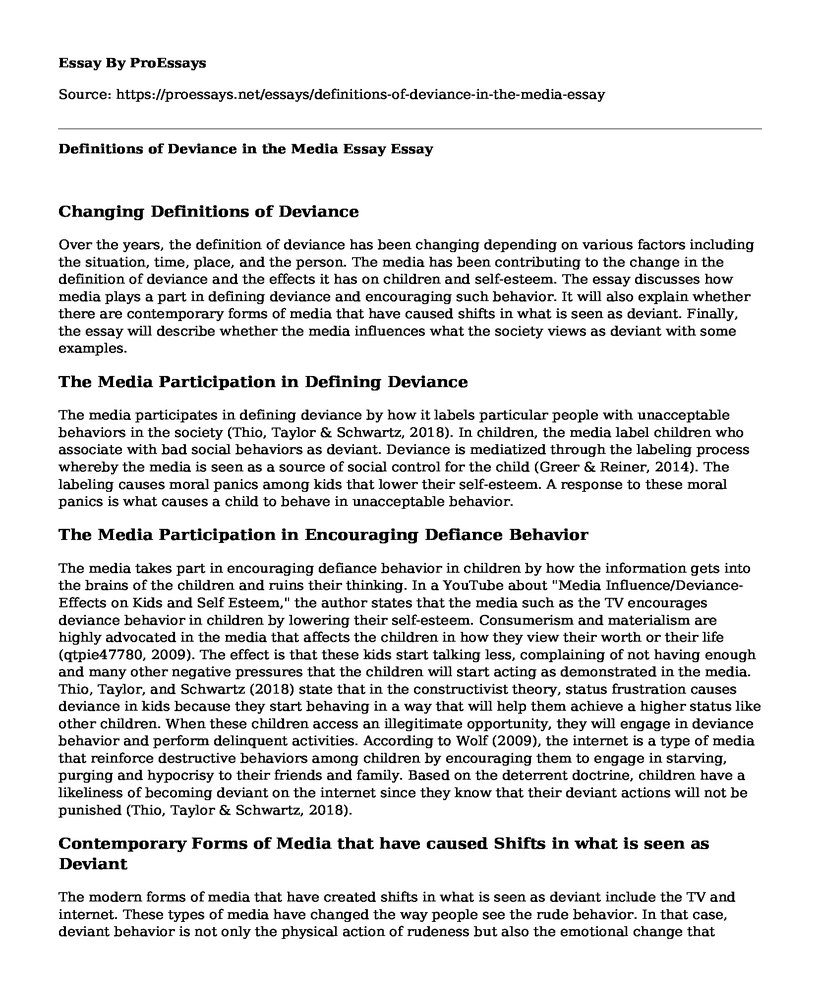Changing Definitions of Deviance
Over the years, the definition of deviance has been changing depending on various factors including the situation, time, place, and the person. The media has been contributing to the change in the definition of deviance and the effects it has on children and self-esteem. The essay discusses how media plays a part in defining deviance and encouraging such behavior. It will also explain whether there are contemporary forms of media that have caused shifts in what is seen as deviant. Finally, the essay will describe whether the media influences what the society views as deviant with some examples.
The Media Participation in Defining Deviance
The media participates in defining deviance by how it labels particular people with unacceptable behaviors in the society (Thio, Taylor & Schwartz, 2018). In children, the media label children who associate with bad social behaviors as deviant. Deviance is mediatized through the labeling process whereby the media is seen as a source of social control for the child (Greer & Reiner, 2014). The labeling causes moral panics among kids that lower their self-esteem. A response to these moral panics is what causes a child to behave in unacceptable behavior.
The Media Participation in Encouraging Defiance Behavior
The media takes part in encouraging defiance behavior in children by how the information gets into the brains of the children and ruins their thinking. In a YouTube about "Media Influence/Deviance- Effects on Kids and Self Esteem," the author states that the media such as the TV encourages deviance behavior in children by lowering their self-esteem. Consumerism and materialism are highly advocated in the media that affects the children in how they view their worth or their life (qtpie47780, 2009). The effect is that these kids start talking less, complaining of not having enough and many other negative pressures that the children will start acting as demonstrated in the media. Thio, Taylor, and Schwartz (2018) state that in the constructivist theory, status frustration causes deviance in kids because they start behaving in a way that will help them achieve a higher status like other children. When these children access an illegitimate opportunity, they will engage in deviance behavior and perform delinquent activities. According to Wolf (2009), the internet is a type of media that reinforce destructive behaviors among children by encouraging them to engage in starving, purging and hypocrisy to their friends and family. Based on the deterrent doctrine, children have a likeliness of becoming deviant on the internet since they know that their deviant actions will not be punished (Thio, Taylor & Schwartz, 2018).
Contemporary Forms of Media that have caused Shifts in what is seen as Deviant
The modern forms of media that have created shifts in what is seen as deviant include the TV and internet. These types of media have changed the way people see the rude behavior. In that case, deviant behavior is not only the physical action of rudeness but also the emotional change that occurs in people when they associate with others who are deviant (Thio, Taylor & Schwartz, 2018). The TV and internet have caused a shift in what is seen as sexual deviance to include not only physical, sexual assault, but also the online sexual activities that a person will engage (Dohring, 2009). Today, children are learning sexual deviance by watching the TV and participating in internet sexual activities. These kids also enter into self-harm groups and hate groups commonly created on the internet. Therefore, deviance is not only a physical act of having a rebellious behavior but also engaging in other unacceptable activities in the virtual world.
Whether the Media Influences what the Society views as Deviant
The media influences what the society considers as deviant by changing their perceptions of what is right and wrong in the community. People will classify an act as deviant when they perceive it to be so. The media is a critical factor in shaping the conceptual boundaries of the recognized and recorded crime (Farrington & Murray, 2014). Over the past years, the society only understood deviance as going against the social values. The introduction of media technology changed this view of deviant as something that not only goes against the social values but also to the benefits of the self. For instance, the TV and internet perpetuated the view of self-harm and low self-esteem as deviant. To the society, these are among the many new deviant behaviors that have emerged due to the use of media. Therefore, the society today emulates much of the views promoted in the media.
References
Dohring, N. M. (2009). The Internet's impact on sexuality: A critical review of 15 years of research. Computers in Human Behavior, 25, 1089-1101.
Farrington, D., & Murray, J. (2014). Labeling Theory: Empirical tests. Advance in criminology theory. Transaction Publishers.
Greer, C., & Reiner, R. (2014). Labeling, deviance, and the media. In: Bruinsma G., Weisburd D. (eds) Encyclopedia of criminology and criminal justice. Springer, New York, NY
Qtpie47780. (2009). Media influence/deviance: Effects on kids and self-esteem. YouTube. Retrieved from https://www.youtube.com/watch?v=BtRQjrtDZCQ
Thio, A., Taylor, J., & Schwartz, M. (2018). Deviant behavior. 12the Edition. Pearson/Allyn and Bacon.Wolf, C. (2009). The hatemongers' new tool: The Internet. CBC News. Retrieved from http://www.cbsnews.com/stories/2009/06/16/opinion/main5092743.shtml
Cite this page
Definitions of Deviance in the Media Essay. (2022, Jul 15). Retrieved from https://proessays.net/essays/definitions-of-deviance-in-the-media-essay
If you are the original author of this essay and no longer wish to have it published on the ProEssays website, please click below to request its removal:
- Research Paper on Brass Bands in New Orleans
- Milford CT: 17 Miles of Shoreline, Unique Shopping & Rich English History - Essay Sample
- Parents: Perfecting Children to Thrive in Society - Research Paper
- Unlocking Personality: Exploring the Thematic Apperception Test - Essay Sample
- Essay on Achieve Well-Being: The Relationship of Psychological & Physical Health
- Essay Example on Free Speech: David Cole's Argument for Its Defense
- Paper Example on Behavioral Finance: Combining Theory with Investment Options







